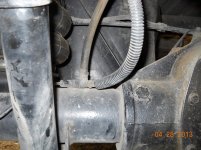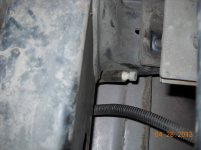wdk450
Well-known member
Gang:
2 years ago, I was on a trip in southern California and noticed the front disk brake pads wear warnings start chirping. I went to a Brake Masters chain shop, had the braking system inspected, and was told I needed new front pads, and that the rear drum linings were fine. Fast forward to the Gillette trip over the Bighorn mountains in Wyoming and coming down the East side into Buffalo, Wyoming. I got behind a gasoline tanker with a good Jake brake, I couldn't seem to shift down more, and I ended up with my front brakes pouring smoke out at a pullout 1/2 way down the mountains. (I now realize I should have pulled over earlier, stopped, shifted all the way down, and proceeded slowly). Anyways, I proceeded on to Gillette and got another brake job the next day with new pads, and again the rear linings are O.K. Wednesday I made a 150 mile trip from Sacramento over to Clearlake climbing and descending some heavy duty hills on Highway 20 West, then over to Soda Bay Road on the southern shore of the lake. Although this route is in the campground (Edgewater in Soda Bay) directions on how to get here, the road is about 15 miles of curving climbs and descents. The entrance to the park and down to the office is a steep downgrade from the road down to lake level. All of my friends in my camping group could smell my brakes as I wrangled the 8 tons of Bighorn down that steep hill. I would guess the front pads are gone again.
I had my CalPak exhaust brake looked at for the 3rd time before I left on this trip and was told it was O.K. I am thinking that I am having problems with my brake proportioner, but know nothing much about these on my era of RAM truck. Some online postings and illustrations show a valve on the rear axle area that has a rod that connects to the sprung bed frame with a rod so that more braking is applied to the rear when the bed is fully loaded. If this is what is there, then I wonder if my recent purchase of rear airbags changes this setup?
Anyways, has anyone with a similar truck had similar problems, and what is the answer??
I saw some postings saying that changing out the brake fluid (they say it gets old and compressible , and changing out any rubber rear brake lines (as they ted to swell with applied pressure with age instead passing the brake fluid pressure through.
I have a free week next week while I am staying in this area, and will see what professional help I can get. I found 1 Dodge dealer nearby, too.
Thanks in advance for the help.
2 years ago, I was on a trip in southern California and noticed the front disk brake pads wear warnings start chirping. I went to a Brake Masters chain shop, had the braking system inspected, and was told I needed new front pads, and that the rear drum linings were fine. Fast forward to the Gillette trip over the Bighorn mountains in Wyoming and coming down the East side into Buffalo, Wyoming. I got behind a gasoline tanker with a good Jake brake, I couldn't seem to shift down more, and I ended up with my front brakes pouring smoke out at a pullout 1/2 way down the mountains. (I now realize I should have pulled over earlier, stopped, shifted all the way down, and proceeded slowly). Anyways, I proceeded on to Gillette and got another brake job the next day with new pads, and again the rear linings are O.K. Wednesday I made a 150 mile trip from Sacramento over to Clearlake climbing and descending some heavy duty hills on Highway 20 West, then over to Soda Bay Road on the southern shore of the lake. Although this route is in the campground (Edgewater in Soda Bay) directions on how to get here, the road is about 15 miles of curving climbs and descents. The entrance to the park and down to the office is a steep downgrade from the road down to lake level. All of my friends in my camping group could smell my brakes as I wrangled the 8 tons of Bighorn down that steep hill. I would guess the front pads are gone again.
I had my CalPak exhaust brake looked at for the 3rd time before I left on this trip and was told it was O.K. I am thinking that I am having problems with my brake proportioner, but know nothing much about these on my era of RAM truck. Some online postings and illustrations show a valve on the rear axle area that has a rod that connects to the sprung bed frame with a rod so that more braking is applied to the rear when the bed is fully loaded. If this is what is there, then I wonder if my recent purchase of rear airbags changes this setup?
Anyways, has anyone with a similar truck had similar problems, and what is the answer??
I saw some postings saying that changing out the brake fluid (they say it gets old and compressible , and changing out any rubber rear brake lines (as they ted to swell with applied pressure with age instead passing the brake fluid pressure through.
I have a free week next week while I am staying in this area, and will see what professional help I can get. I found 1 Dodge dealer nearby, too.
Thanks in advance for the help.



